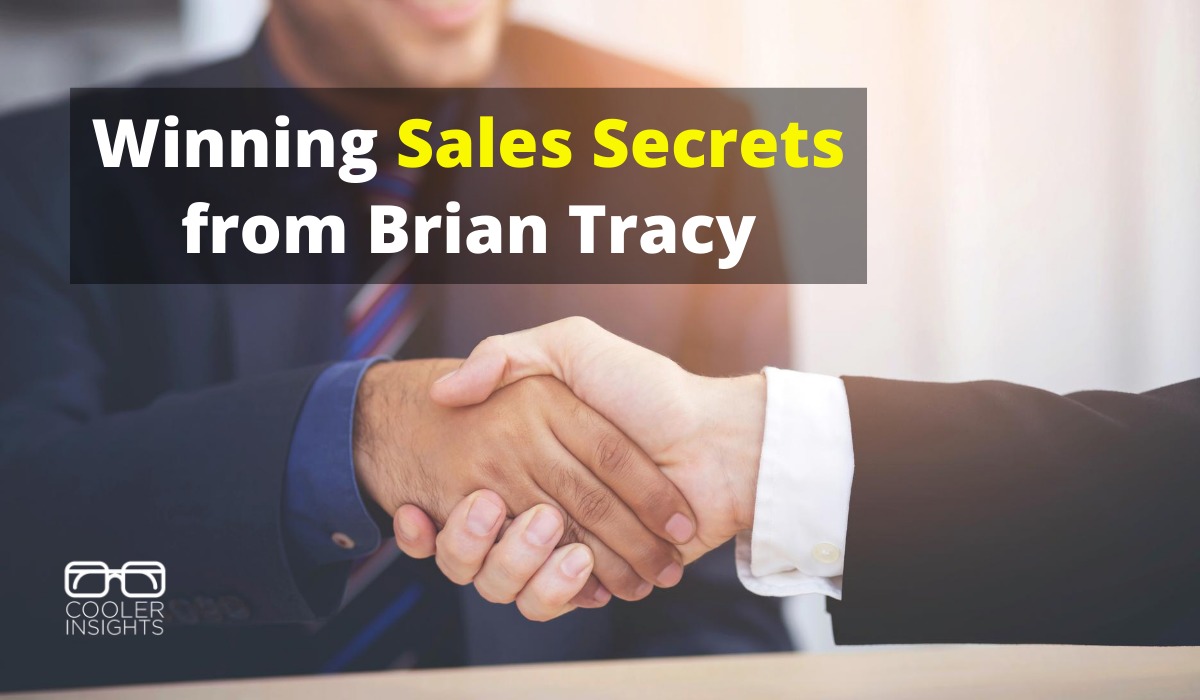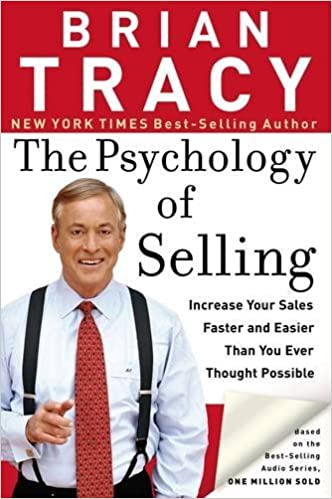
What is the secret to great sales—both online and offline? How can you convince a prospect to buy from you?
To learn the art and science of better sales, I decided to listen to The Psychology of Selling: Increase Your Sales Faster and Easier Than You Ever Thought Possible—an evergreen bestseller from master sales trainer Brian Tracy.
And boy, did it blow my mind!
In this book summary of The Psychology of Selling, you will learn some of the top selling strategies and tactics used by top sales people around the world.
Ready to roll in the dough through better sales? Let’s go!
Get into the Right Selling Mindset
The art and science of selling like a champ begins with getting into the right mindset.
Take note of the Pareto Principle or the 80/20 rule – “The top 20 percent of salespeople will make 80 percent of money. The bottom 80 percent of sales people makes 20 percent of the money.”
Cultivate a positive self-concept. Visualise yourself earning a handsome income from sales and work towards that goal.
Once you’ve decided to be a top salesperson, tap your fullest potential and follow the leaders. To do so, follow these steps:
- Engage in positive self-talk
- Affirm yourself through visualization–set a sales goal to programme your subconscious mind
- Schedule and write what you need to do–determine the number of calls, appointments, presentations and callbacks you need to do each day to achieve your goal
- Motivate yourself by writing down the reasons for increasing your sales and your income
- Sign up for sales training
- Continually improve your technique
Master the 7 Key Areas of Selling
To be a top salesperson, you need to master the 7 key areas of selling:
- Prospecting–How you reach, contact, and communicate to potential customers
- Building Rapport–The art of building a positive relationship with a prospect
- Identifying Needs–Studying and researching the needs and wants of your prospect
- Presenting–Showcasing how your product or service meets the needs of your prospect
- Answering Objections–How you respond to the natural resistance from your prospect
- Closing the Sale–How you lead a prospect to buy from you
- Getting Resales and Referrals–Getting a satisfied customer to buy more and refer potential customers to you
Set Sales Goals (and Schedule Your Calendar)
Goal setting is key as it helps determine what you do and what you wish to achieve.
Consider the following goals:
- Annual income goals–How much do you want to earn each year?
- Annual sales goals–How many units do you need to sell to achieve your income?
- Monthly, weekly and daily goals–Break down your goals into smaller milestones
- Activity goals or desired hourly rate–Set activity goals for each hour that help you achieve the above-mentioned
- Personal goals–determine why you are doing what you do, and seek to be self-motivated
Organise your goals in terms of value and priority, and schedule your calendar according to them.
Learn Why People Buy–and Communicate These Reasons
According to Tracy, every buying decision is “100% emotional.” Often, your customer will use a logical reason to justify an emotional response to buying (or not buying).
There are two primary motivations for your customers to buy:
- Desire for gain–they’re looking for a way to improve themselves
- Fear of loss–they’re afraid that purchasing your good or service may be a mistake if it is of no use to them
Consider incorporating these 11 emotional needs when you communicate with a prospect:
- Money–Associate your product or service with making or saving money for your customer
- Security–Help your prospect to feel more safe and secure with your offer
- Being Liked–Can your product or service increase the likability of your prospect? How can it make them admired by their peers? Let them know!
- Status and Prestige–We are all egoistic creatures. Hence, see if you can appeal to your prospect’s sense of prestige and pride.
- Health and Fitness–Everybody wants to look good, feel better, and have more energy
- Praise and Recognition–Are you able to position your product or service as a way for your prospect to gain greater recognition, and status? Luxury cars and yachts are good examples.
- Power, Influence and Popularity–How can your product help her be more influential? What can it do to make her more popular?
- Leading the Field–Communicate how your product or service can help your customer to be at the top of his game.
- Love and Companionship–Make your prospect feel desirable as a companion
- Personal Growth–Associated with Maslow’s Self-Actualisation, the goal is to make your prospect feel that they can achieve even greater heights of success and self-realization
- Personal Transformation–Show how your product or service not only improves your prospect’s situation, but can turn them into a different person. (The same applies for organisations.)
The Four Principles of Selling and Marketing
Do not attempt to sell to everybody. Instead, adopt Tracy’s four principles:
- Specialisation–Determine what you want to specialize in and hone your skills in that arena
- Differentiation–Demonstrate how your offer is different from the competition. What is your Unique Selling Proposition? How are you different yet valuable to your customer?
- Segmentation–Zoom in on the specific customers in your market. Who are they and what do they want?
- Concentration–Put all of your energy and efforts on a specific area.
How to Get More Appointments
Here, Tracy recommends the following rules:
- Break prospect preoccupation–Don’t just launch straight into your pitch. Ask for permission first, eg “I need two minutes of your time. Is this a good time to talk?”
- Sell the appointment, not the product–Do not talk about your product or pricing on the phone (or via an instant message or email) unless you can close the deal directly. Chances are, you can’t, hence it is better to get an appointment first.
- Choose your words carefully–Make your opening line equivalent to a “brick going through their window” and focus on your customer’s benefits rather than your product or service directly.
Use the Power of Suggestion to Sell
Being calm, confident and relaxed helps you to sell better. It also sets your prospect at ease.
Beyond this, consider how you can control your selling environment and surroundings:
- Be positive, upbeat and cheerful
- Control your voice and pitch–make it uplifting!
- Practice, practice, practice! Know your script inside out…
- Dress for success and groom yourself well
- Use a pleasant surrounding to sell
- Be professional when you present
- Shake hands firmly
- Sit straight and minimise interruptions. Keep your smartphone away!
The Three-Part Sales Presentation
Make your selling proposition more compelling with the following strategies:
- Simultaneously show how much better it will be for your prospect to buy and how much worse it will be if they don’t buy
- Reduce their fear of loss by offering a money-back guarantee or gifts with high perceived value
- Focus on the 5 to 10 most attractive benefits of your product/ service
- Start with the most important and go down in descending order
Use the three-part sales presentation format when you present:
- Because of this…(product feature)
- You can…(product benefit)
- Which means…(customer benefit)
How to Close the Sale
This is so important. A key thing here is to neutralize sales resistance.
To do so, tell your prospects that you understand their concerns and the issues behind their resistance. Get ready to counter it with social proof, as well as benefits of your product and service.
Prepare a list of FAQs in advance of your sales meeting (these also work well in content marketing).
There are three main ways to close the deal:
#1 The Approach Close
Your goal is to get your prospect to agree to make a decision AFTER you’ve made your presentation.
Don’t let your prospect say, “Let me think about it,” or “I need to discuss this.” That often spells the death knell of the sale.
Instead, say something like this: “Relax, I’m not trying to sell you anything right now. That’s not the purpose of my visit.”
Pause for effect.
And then continue, “All I ask is that you look at what I have to show you with an open mind, determine if it applies to your situation, and tell me at the end of our conversation if this product makes sense for you.”
#2 The Demonstration Close
Begin your meeting by asking your prospect if they will make a purchase if you can demonstrate the key benefit of your product.
Here are some suggested phrases:
“If I could show you that this machine will save up to 20 percent of your running cost, will you invest [price] in changing your factory right now?”
“If you learn that this [investment product] is the best option available for you in the market right now based on your needs, will you invest [dollar sum] right now?”
#3 The Power of Suggestion Close
This is another approach, where you try to communicate based on the assumption that your customer already bought and used your product or service.
You could say something along these lines: “This beautiful view of the lake with that cherry tree in the corner can be yours next week.” or “Your days of managing accounts manually are over.”
The Six Basic Types of Buyers
To ensure that you do not bark up the wrong tree, Tracy recommends that you identify your potential buyer based on his or her characteristics as follows:
- The Apathetic Buyer–Always negative and perpetually telling you that they have no money to buy. Don’t waste time with them. Exit and move on at the earliest opportunity.
- The Self-actualizing Buyer–These dream prospects know exactly what they want. Your job is not to talk them into anything which they haven’t set their hearts and minds on.
- The Analytical Buyer–Focused on calculating ROI, task-oriented, and self-contained. Your goal is to prove on paper and work out what benefit they will get.
- The Relater Buyer–Relationship-focused, these tend to be in helping professions like healthcare, education, or service lines. Focus on other happy customers, build a relationship with them, and don’t rush.
- The Driver Buyer–Boss-type person, who is direct, impatient and concise. He wants to cut to the chase. Don’t waffle or make small talk. Dive straight into the benefits and how it helps.
- The Socialized Buyer–Achievement-oriented and hence, as soon as you reach an agreement, you should document it and send a copy to them. Also, such buyers may forget what was spoken since they love to make small talk.
Conclusion
Written by a famed personal development and leadership expert, The Psychology of Selling provides a good foundation for anybody who needs to sell.
As a marketer and a content strategist, selling isn’t quite my thing. However, I have gleaned many valuable gems of wisdom from the book, and hope that you’ve found my summary useful.
Do you need to sell as part of your profession? What has been the greatest challenge for you?


Consultancy take up the major responsibility in fulfilling client’s lifetime goal to the fullest breaking their fear.When you choose the right and trusted consultancy like us. We not only mould but also make you into survival of the fittest. Our,
Krysalis consultancy is to make their future in the way, they want to have.
this post is very informational